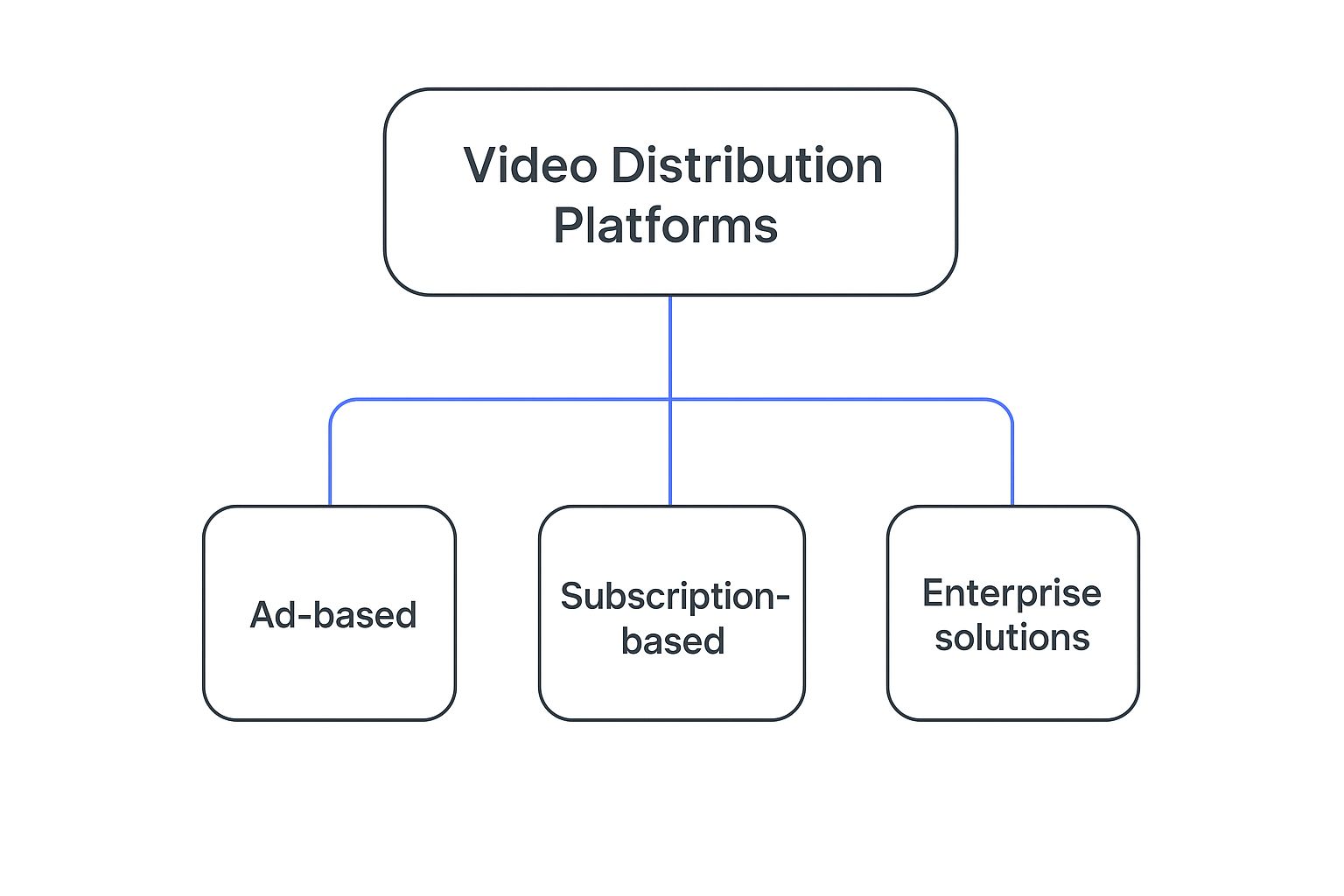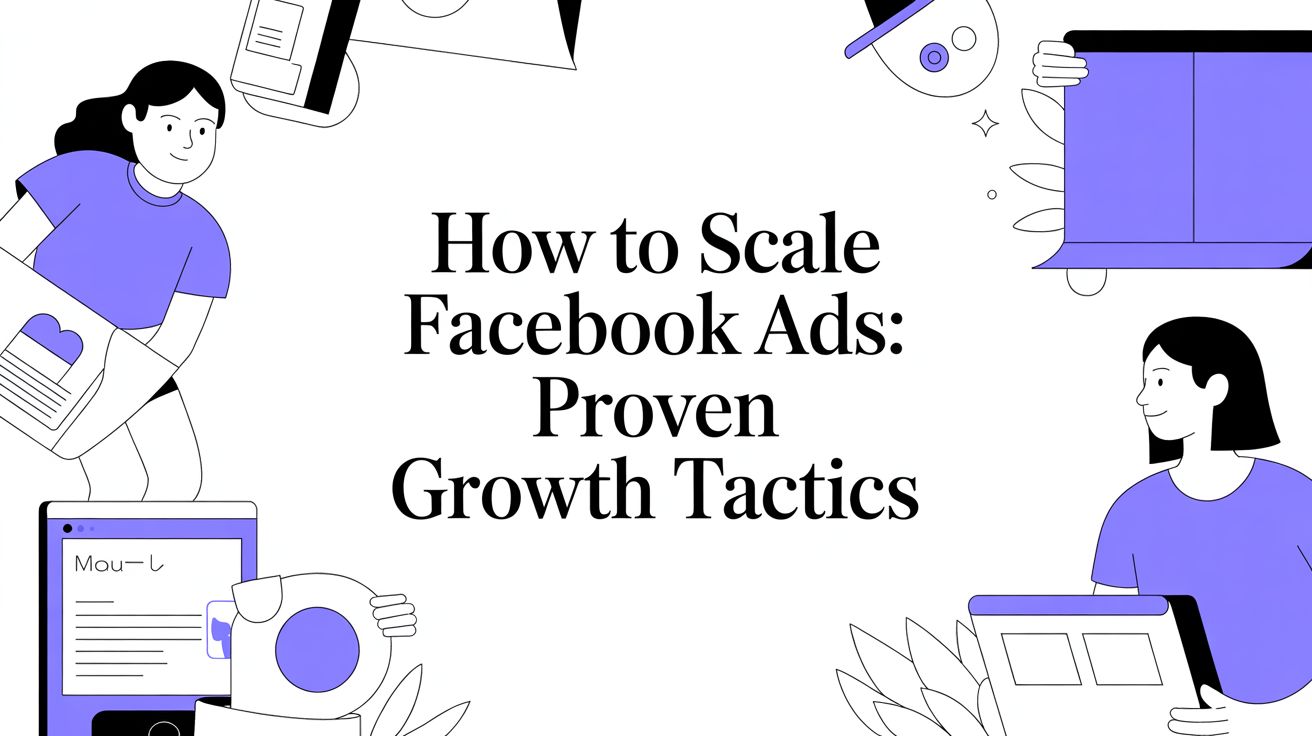Why Video Distribution Platforms Matter More Than You Think
Imagine you’ve poured your heart and soul into creating the perfect video. The script is tight, the visuals are stunning, and the editing is seamless. You proudly hit "publish," anticipating a flood of views...but then, nothing. Sound familiar? This disheartening scenario is all too common for creators who underestimate the power of video distribution platforms.
These platforms aren’t just digital storage lockers for your content. They're more like sophisticated matchmaking services, connecting your videos with the right audiences. Think of it this way: you could have the most amazing product in the world, but if nobody knows about it, it won't sell. The same principle applies to video content.
Your videos need a stage, and that's where video distribution platforms come in. They provide the infrastructure and tools to showcase your work to the world. But it's not just about views; it's about achieving your specific goals. Are you trying to build brand awareness? Drive sales? Educate your audience? Different platforms excel in different areas.
Choosing the Right Platform For Your Needs
Picking the right platform is crucial. Using the wrong one is like trying to force a square peg into a round hole – frustrating and ultimately ineffective. Take YouTube, for example.
YouTube's homepage is designed for mass audience reach and diverse content discovery. Notice the variety of videos, the prominent search bar, and the emphasis on recommended content. These features are designed to connect viewers with content they enjoy, even if they weren't actively looking for it.
The Growing Importance of Video Distribution
The online video market is exploding. It's projected to reach a staggering $2.49 trillion by 2032, growing at a compound annual growth rate (CAGR) of 17.8%. Learn more about video streaming market statistics. This rapid expansion makes it even more important to stand out from the crowd.
With so much competition, a solid distribution strategy isn’t just an advantage; it’s a necessity. The question isn't if you need a video distribution strategy, but which platforms will best serve your unique needs and help your videos reach their full potential.
The Three Pillars Every Platform Must Master
Think of a successful video distribution platform like a three-legged stool. It needs delivery infrastructure, discovery mechanisms, and data intelligence to stand strong. Remove one leg, and the whole thing topples over.
Delivery Infrastructure: Ensuring Seamless Playback
Delivery infrastructure is the stool’s base, ensuring your videos play smoothly, no matter where your viewers are or what device they're using. We've all experienced the frustration of a buffering video. A robust delivery network, using Content Delivery Networks (CDNs) like Amazon CloudFront or Akamai, positions your content closer to your audience, minimizing lag and maximizing viewing pleasure. It’s like having strategically placed warehouses full of your videos, ready to be delivered instantly to viewers around the globe.
Discovery Mechanisms: Connecting With Your Audience
Now that your videos play smoothly, people need to find them. This is where discovery mechanisms come in – the second leg of our stool. These include search algorithms, recommendation engines, and promotional tools. Think about how YouTube suggests videos based on your watch history. That’s a discovery mechanism at work, connecting you with content you might enjoy even if you didn't know you were looking for it. Effective discovery ensures your videos reach the right eyes, turning casual browsers into engaged viewers.
This infographic categorizes the main types of video distribution platforms:

Platforms usually focus on ad-based, subscription-based, or enterprise models, each with unique strengths and weaknesses related to our three pillars. Creating compelling video ads for these platforms is crucial for success; you might find this article on creating dynamic video ads helpful.
Data Intelligence: Measuring and Optimizing Performance
Finally, we have data intelligence – the brains of the operation, the third leg of our stool. This pillar provides crucial insights into viewer behavior: how long they watch, how they engage, and who they are. It’s like having a backstage pass to understand your audience's viewing habits. Armed with this knowledge, you can refine your content strategy, making informed decisions about future videos. This could involve tweaking video length, trying different calls to action, or even creating tailored content for specific segments of your audience.
To illustrate this, let’s look at Vimeo’s homepage:

Vimeo’s focus on creative professionals demonstrates a deep understanding of its target audience. This targeted approach shapes their delivery infrastructure (supporting high-quality video), discovery mechanisms (highlighting portfolios and creative communities), and data intelligence (providing metrics relevant to professional creators).
To understand how different platform types excel across these three pillars, take a look at the table below:
Platform Strength Analysis Framework: A strategic comparison showing how different platform types excel across the three essential pillars of video distribution.
| Platform Category | Delivery Excellence | Discovery Features | Data Intelligence | Ideal Application |
|---|---|---|---|---|
| Ad-Based Platforms (e.g., YouTube) | Robust CDNs, adaptive bitrate streaming | Sophisticated search algorithms, recommendation engines | Extensive viewer data, ad performance metrics | Reaching wide audiences, building brand awareness |
| Subscription-Based Platforms (e.g., Vimeo) | High-quality video support, advanced security features | Curated content, community features | Detailed engagement metrics, subscriber analytics | Niche content, premium offerings |
| Enterprise Platforms (e.g., Wistia) | Customizable video players, integration with marketing tools | Lead generation features, gated content | Advanced analytics, CRM integrations | Internal communications, marketing automation |
Each platform prioritizes these pillars differently. Choosing the right balance for your needs is essential for a successful video distribution strategy.
Mapping The Platform Ecosystem Beyond The Obvious Choices
Most people associate video distribution with YouTube. It's an understandable connection, but a limited one. Imagine thinking cars are the only way to travel. You'd miss out on trains, planes, and boats – all designed for different journeys. The world of video distribution platforms is much the same, stretching far beyond the usual suspects.
This diverse ecosystem caters to a variety of needs. Consumer platforms like TikTok and Instagram prioritize viral trends and social interaction. They thrive on short, engaging content designed for quick consumption and easy sharing. Think a funny product demo or a catchy dance challenge. But a long training video or a confidential company announcement? Probably not the best fit.

Netflix's homepage, for example, showcases its extensive on-demand library. Personalized recommendations and original series take center stage. The prominent search bar and categorized browsing options emphasize user experience and content discovery. This illustrates how platforms tailor their design to specific audiences and content.
Navigating the Nuances of Platform Categories
Unlike consumer platforms, enterprise solutions like Brightcove focus on security and in-depth analytics. These platforms are built for businesses that need controlled distribution, detailed performance metrics, and strong security measures.
Then there are specialized platforms like Twitch, designed for particular communities, such as gamers. These platforms facilitate live interaction and real-time engagement. It's like choosing the right tool for a job – a hammer for nails, a screwdriver for screws. Each platform excels in its own area.
For example, educational platforms like Kaltura prioritize integration with learning management systems. This allows educators to seamlessly blend video content into their courses, track student engagement, and manage assignments all in one place. Even in the competitive US streaming market, platforms like Amazon Prime Video and Netflix dominate, each holding over 20% market share as of 2025. This intense competition highlights the need for smart platform choices. Discover more insights about the US streaming market.
So, successful video distribution isn’t about finding the single “best” platform. It's about picking the platform that best suits your specific goals and your target audience.
Matching Platforms To Purpose Through Real Success Stories
Choosing the right video distribution platform can make or break your video strategy. It's like choosing the right vehicle for a journey – a sports car might be great for a quick trip on a smooth highway, but it won't get you far on a rugged mountain trail. Similarly, a platform with massive reach might seem ideal, but if your target audience isn't there, it's ultimately ineffective. Let's explore how real organizations have navigated this critical decision, learning from their experiences.
Consider a local restaurant chain that initially used YouTube for employee training videos. YouTube’s vast reach seemed like a logical choice. However, their training content got lost amidst the sea of cat videos and music clips, and employee completion rates were dismal. Reach without relevance is like having a loudspeaker in a deserted town square – lots of potential, but no one to hear your message. Switching to Vimeo's business tier, with its focus on professional content and enhanced privacy controls, was like trading the sports car for a reliable 4x4. Their completion rates soared by 340%, proving that the right platform can unlock significant results.
The Importance Of Platform Alignment
Another example involves a SaaS startup struggling with product demo videos. Initially hosted on their website, these videos caused bandwidth issues and slow load times. Imagine trying to stream a high-definition movie over a dial-up connection – frustrating, right? Migrating to Wistia, a platform specifically designed for business video hosting, solved their technical woes. Moreover, Wistia’s built-in lead generation tools transformed passive viewers into qualified prospects. Choosing Wistia wasn't just about fixing technical problems; it was about adding a powerful marketing engine to their video strategy. You might be interested in exploring video asset management in more depth.
Finding The Right Fit Across Industries
These anecdotes illustrate a broader principle: effective video distribution requires a strategic approach. Different industries face unique challenges and require tailored solutions. Universities, for example, often use YouTube for public lectures to maximize reach and accessibility. However, for private course materials, they might choose specialized learning platforms like Kaltura, which offer secure access and integration with learning management systems. It's like choosing between a public library and a university archive – each serves a distinct purpose.
The Wistia website highlights its focus on business video hosting, showcasing features designed for a specific audience.
Similarly, healthcare organizations often prioritize HIPAA-compliant video platforms for patient communications, putting security and privacy first. Entertainment companies, on the other hand, might employ a multi-platform approach, using YouTube for trailers and behind-the-scenes content, while leveraging streaming services like Netflix for premium releases. It's about understanding the nuances of each platform and using them strategically.
The global demand for tailored content is fueling the media streaming market, projected to reach $108.73 billion in 2025 and expected to grow at a CAGR of 8.6% until 2032. Discover more insights on this market growth. This growth underscores the importance of choosing the right distribution platforms.
To help you navigate this landscape, the following table provides a framework for aligning your business objectives with the appropriate platforms.
Strategic Platform Selection By Business Goal: A comprehensive guide showing which platforms align with different business objectives and content strategies.
| Business Objective | Recommended Platforms | Critical Features | Investment Level | Success Indicators |
|---|---|---|---|---|
| Broad Reach & Public Awareness | YouTube, Facebook, Vimeo | Public accessibility, SEO optimization, social sharing | Low to Medium | Views, Shares, Engagement |
| Lead Generation & Marketing | Wistia, Vidyard | Lead capture forms, analytics, marketing integrations | Medium to High | Leads, Conversions, ROI |
| Internal Training & Communication | Vimeo Enterprise, Kaltura, MS Stream | Privacy controls, secure access, LMS integration | Medium to High | Completion rates, employee engagement |
| Premium Content Distribution | Netflix, Amazon Prime Video, Hulu | Subscription model, high-quality streaming, exclusive content | High | Subscribers, Revenue |
| Healthcare Communications | HIPAA-compliant platforms | Security, privacy, patient data protection | Medium to High | Secure communication, patient satisfaction |
This table provides a starting point for your platform selection process. Remember, the "best" platform is the one that best aligns with your specific goals and audience.
The True Cost Of Platform Decisions Beyond Monthly Fees
When choosing a video distribution platform, it's easy to get fixated on the monthly subscription fee. But that's often just the beginning of the story. Think of it like buying a car – the sticker price is one thing, but then you have gas, insurance, and maintenance. Similarly, seemingly affordable video platforms can hide costs that quickly add up.
Hidden Costs That Can Drain Your Budget
Bandwidth and storage are two common culprits. Imagine your video takes off unexpectedly. Suddenly, you have a lot more viewers than you planned for. This can lead to bandwidth overage charges, much like going over your data limit on your phone. And as you add more videos to your library, storage fees can steadily increase. These seemingly small amounts can snowball over time, making a "cheap" platform quite expensive.

Brightcove's website, shown above, highlights enterprise-level solutions. While these may have higher upfront costs, they often provide more bandwidth and storage, minimizing the risk of surprise overage fees. It’s like buying a slightly more expensive car that gets better gas mileage – it might be cheaper in the long run.
Then there's the hidden cost of inadequate analytics. Without good data on viewer behavior, you’re essentially driving with your eyes closed. You can’t see what's working and what's not, making it hard to improve your content. Similarly, limited customization can force you into expensive workarounds. Trying to make a platform do something it's not designed for is like fitting a square peg in a round hole – it might work, but it’s not ideal.
The Long-Term Benefits Of Smart Investments
Investing in a more robust platform can actually save money in the long run. A platform that integrates hosting, analytics, and other tools can eliminate the need for separate subscriptions, like bundling your cable, internet, and phone service. You can also explore and compare various pricing plans using resources like Sprello to get a better grasp of the factors impacting cost.
Think of a business that initially used different platforms for hosting, analytics, and lead capture. By switching to a single, integrated platform, they streamlined their workflow, reduced software costs, and gained a clearer picture of their video performance. It’s like switching from multiple single-purpose kitchen gadgets to a single multi-function appliance.
Another crucial factor is the opportunity cost of poor platform performance. Slow loading times and buffering can frustrate viewers and hurt your brand's image. Imagine a potential customer trying to watch your product demo, only to be met with constant buffering. They'll probably give up and go elsewhere. By investing in a platform that provides a smooth viewing experience, you’re investing in customer satisfaction and your brand’s reputation. By considering the total cost of ownership, including these hidden expenses, you can make smarter decisions that pay off over time.
Building A Future-Ready Video Strategy That Adapts
The online video world is constantly changing. Remember Vine? Or Google+? Putting all your eggs in one basket by relying on a single platform for your video strategy is a risky move. Savvy organizations understand this and build adaptable strategies that can flex and change along with technology and viewer habits.
Adapting to Emerging Trends in Video Distribution
Several key trends are shaping the future of how we distribute video. Interactive video, for instance, is becoming less of a novelty and more of a necessity. Think about quizzes, polls, and shoppable videos – features that transform passive viewers into active participants. Then there’s mobile-first design, which is no longer a nice-to-have, it's essential. Your videos need to look and work flawlessly on phones and tablets, since that's where most people are watching. AI-powered personalization is also becoming the norm. Viewers expect platforms to suggest videos relevant to their individual interests, much like Netflix or YouTube does. Lastly, accessibility features, like captions and transcripts, are not just legally important – they also broaden your reach and boost your search engine optimization (SEO).
These features cater to a broader audience and signal to search engines that your content is valuable, which can improve visibility.

JW Player emphasizes adaptability and future-proofing, as seen in the screenshot above. They highlight their flexibility across different platforms and devices, suggesting a focus on meeting the ever-changing demands of video distribution. It’s this kind of thinking that allows you to navigate the shifting sands of online video.
Evaluating Platforms for Long-Term Success
Companies that plan for the future evaluate video platforms based on their development roadmap and how well they play with other systems. They ask questions like: "Is this platform investing in new technologies?" and "Does it integrate easily with other tools we already use?" Choosing platforms with a strong vision for the future allows your strategy to grow with the times instead of becoming outdated.
Building Strong Platform Relationships
Having a solid relationship with platform representatives is a smart move. It's like having a knowledgeable friend on the inside. They can give you a heads-up about upcoming features, offer help when you run into technical snags, and even advise you on optimizing your content strategy. These relationships can give you a real edge and help you make informed decisions as the video landscape evolves. By focusing on adaptability, planning for the long haul, and cultivating those key platform relationships, you can build a video distribution strategy that not only survives but thrives in the dynamic world of online video.
Your Platform Selection Framework That Actually Works
Choosing the right video distribution platforms can feel a bit like navigating a sprawling farmers market. So many options! It's not about finding the single "best" tomato, but the right combination of ingredients for your specific culinary masterpiece. This section provides a practical framework, guiding you from assessing your recipe to asking the right questions at each vendor's stall.
Defining Your Video Distribution Goals
First, what's cooking? Are you whipping up a viral marketing campaign, a hearty internal training program, or a delicate dish of brand awareness? Each goal requires a different approach. For example, a public awareness campaign might flourish on the bustling marketplace of YouTube, while confidential training videos need the secure, climate-controlled environment of something like Vimeo Enterprise. Understanding your "why" is the essential first ingredient.
Prioritizing Features Based on Business Impact
Next, which tools will make your recipe sing? Don't be distracted by shiny gadgets. If lead generation is your main course, focus on platforms with robust analytics and lead capture tools, like sharp knives and measuring spoons. If brand consistency is key, prioritize customizable players and branding options, like a beautiful serving platter and personalized garnish. Feature lists are useful, but real business impact should be your head chef.
Unveiling Platform Limitations
Platform demos can be like perfectly plated samples. Tempting, but not the whole story. Go beyond the scripted presentation and ask pointed questions that reveal potential limitations, like checking the expiration date or ingredient list. For instance, inquire about bandwidth limits, especially if you anticipate a rush of hungry customers. Understand how storage costs scale with your video library’s growth – will your pantry shelves hold up? Explore integration options with your existing marketing tools. Do they plug into your current kitchen setup, or will you need adapters? These questions often uncover hidden costs or compatibility issues.
This screenshot shows the help center for YouTube, like a detailed instruction manual. While helpful, it also highlights the potential complexity of operating larger platforms. Sometimes, a simpler tool is easier to master.
Decoding Pricing Red Flags
Be wary of pricing structures that seem too good to be true. "Unlimited" anything often comes with fine print. Understand how overage charges are calculated. Are there hidden fees like delivery or service charges? Look for transparent pricing models that align with your usage patterns. A slightly higher upfront cost with predictable scaling might be more economical than a low entry price with surprise add-ons. Think of it like choosing between a farm-fresh ingredient versus a processed food item: the initial cost may be higher, but the long-term value is often greater.
Ensuring Seamless Integrations
Integration with your existing marketing technology stack is crucial. A platform that seamlessly integrates with your CRM, marketing automation, or analytics tools can streamline your workflow and provide valuable data insights. It’s like having all your appliances working together in perfect harmony. Ask about API access and available integrations. A standalone platform might require manual data transfer, creating workflow inefficiencies, like having to chop vegetables by hand when a food processor could do the job in seconds.
This framework empowers you to move beyond marketing hype and make informed decisions. Whether you're a solo food blogger or a large restaurant chain, this methodical approach ensures your chosen video distribution platforms align with your strategic objectives and deliver measurable results. Bon appétit!



